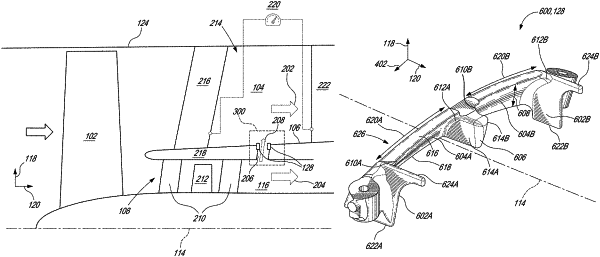| CPC F02C 9/18 (2013.01) [F02C 6/08 (2013.01); F02C 7/18 (2013.01); F05D 2240/12 (2013.01); F05D 2260/606 (2013.01)] | 11 Claims |

|
1. A device for guiding bleed air into a bypass duct of a turbofan engine having a central axis, the device comprising:
a body defining a first flow-guiding surface having opposite first and second ends defining a span of the first flow-guiding surface around the central axis, the first flow-guiding surface extending between a radially-inner edge of the body and a radially-outer edge of the body relative to the central axis; and
a first side wall adjacent the first end of the first flow-guiding surface of the body, the first side wall extending at least partially axially relative to the central axis, the first side wall extending from a first position radially inwardly of the radially-inner edge of the body to a second position radially outwardly of the radially-inner edge of the body relative to the central axis;
wherein:
the body defines a second flow-guiding surface having opposite first and second ends defining a span of the second flow-guiding surface around the central axis, the second flow-guiding surface extending between the radially-inner edge of the body and the radially-outer edge of the body relative to the central axis, the second flow-guiding surface being angularly spaced apart from the first flow-guiding surface relative to the central axis;
the first end of the first flow-guiding surface is distal to the second flow-guiding surface;
the second end of the first flow-guiding surface is proximal to the second flow-guiding surface;
the first end of the second flow-guiding surface is proximal to the first flow-guiding surface;
the second end of the second flow-guiding surface is distal to the first flow-guiding surface;
the device includes a second side wall adjacent the second end of the second flow-guiding surface of the body, the second side wall extending at least partially axially relative to the central axis;
the device comprises a third side wall adjacent the second end of the first flow-guiding surface of the body, the third side wall extending at least partially axially relative to the central axis;
the device comprises a fourth side wall adjacent the first end of the second flow-guiding surface of the body, the fourth side wall extending at least partially axially relative to the central axis;
the third and fourth side walls are planar and divergent in a radially outward direction relative to the central axis; and
the third and fourth side walls cooperatively define a V-shaped center piece that is pointing radially-inwardly relative to the central axis and that is positioned between the first flow-guiding surface and the second flow-guiding surface.
|